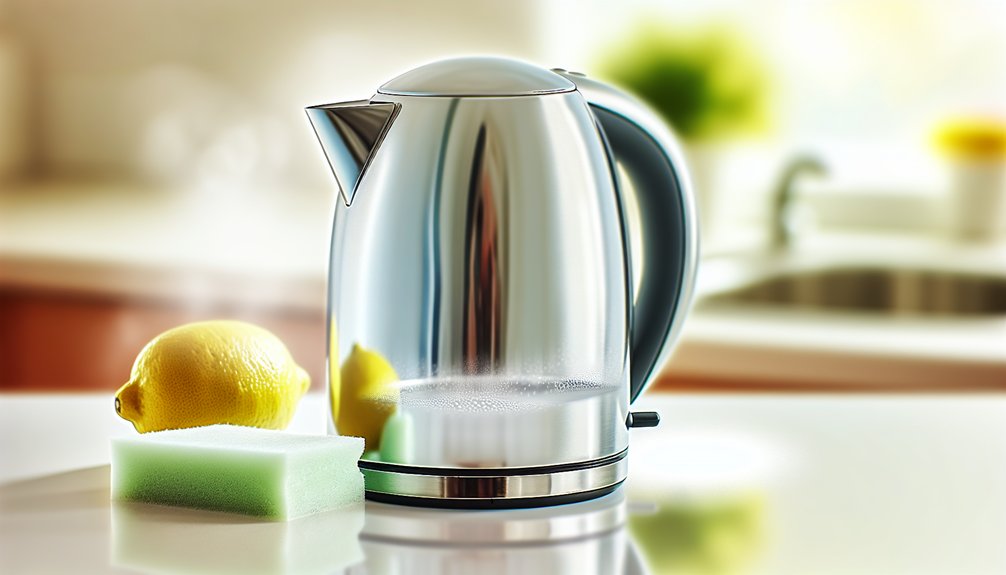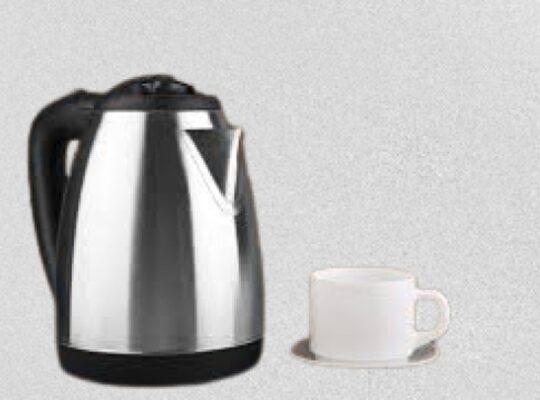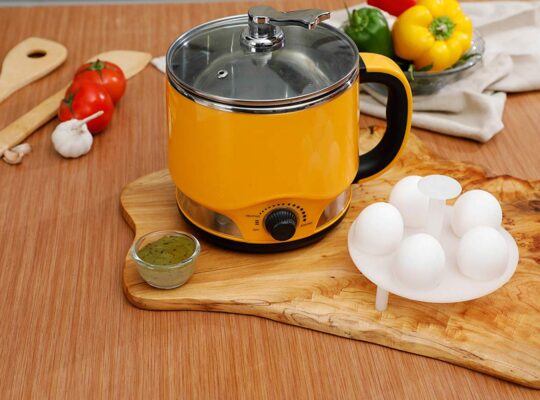To clean your electric kettle from the inside, mix equal parts water and vinegar, filling it to the max level. Let it sit for 30 minutes, then boil the mixture before rinsing thoroughly. For tough stains, use a baking soda solution (1 tablespoon baking soda to 1 cup water) and scrub gently with a soft sponge. You can also try lemon juice for a fresh scent. Regular maintenance keeps your kettle efficient, and you’ll find more helpful tips ahead.
Key Takeaways
- Mix equal parts of water and vinegar, fill the kettle, and let it sit for 30 minutes for effective cleaning.
- For stubborn stains, combine 1 tablespoon of baking soda with 1 cup of water and scrub gently with a soft sponge.
- Use fresh lemon juice mixed with water, boil it, and let it sit to freshen and clean the kettle’s interior.
- Rinse the kettle thoroughly with fresh water after each cleaning solution to remove any residual smell or residue.
- Clean the kettle every few weeks based on usage to prevent limescale buildup and maintain optimal performance.
Understanding Limescale and Its Impact
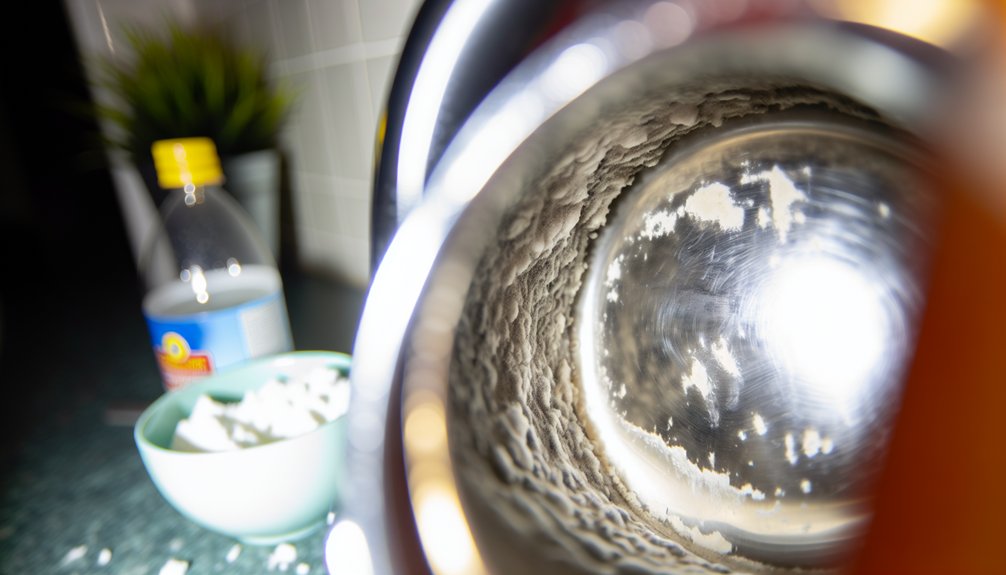
Limescale, that stubborn white mineral buildup, can greatly affect your electric kettle’s performance and longevity. If you’ve noticed a chalky residue inside your kettle, it’s likely due to limescale buildup from hard water. This accumulation not only decreases the efficiency of your kettle but can also lead to longer boiling times, wasting energy and time. Additionally, limescale can interfere with the heating element, causing potential damage or reducing its lifespan. You might even notice a change in the taste of your water or tea, as the mineral deposits can leach into your beverages. Regularly addressing limescale buildup is essential for maintaining peak performance, ensuring your kettle stays effective and extends its operational life. Regular maintenance is recommended to prevent buildup and keep your kettle in optimal condition.
What You’ll Need for Cleaning
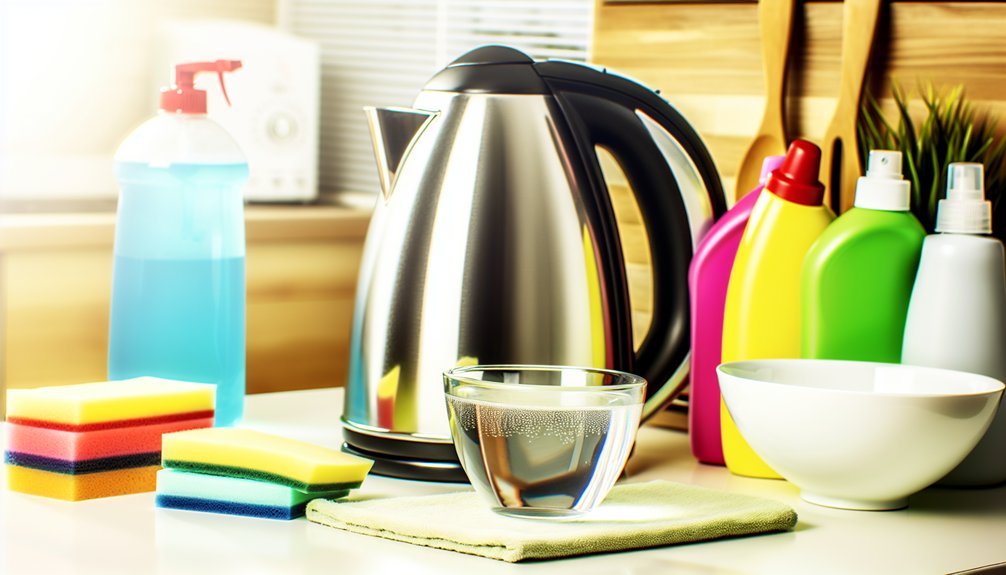
To effectively clean your electric kettle and tackle that limescale buildup, you’ll need a few essential items. First, gather your cleaning tools: white vinegar or lemon juice, which are great for breaking down mineral deposits. You’ll also need a soft sponge or cloth to avoid scratching the kettle’s interior. Don’t forget a measuring cup for accurate mixing.
Safety gear is equally important. If you’re using vinegar, it can be strong-smelling, so consider wearing gloves to protect your hands. Keep your kettle unplugged during the cleaning process to avoid any accidents. With these items on hand, you’ll be ready to give your kettle the deep clean it deserves, ensuring it functions efficiently for your daily tea or coffee. Regular cleaning helps maintain the efficiency of the heating element, which is essential for boiling liquid inside the kettle.
Vinegar Method for Deep Cleaning
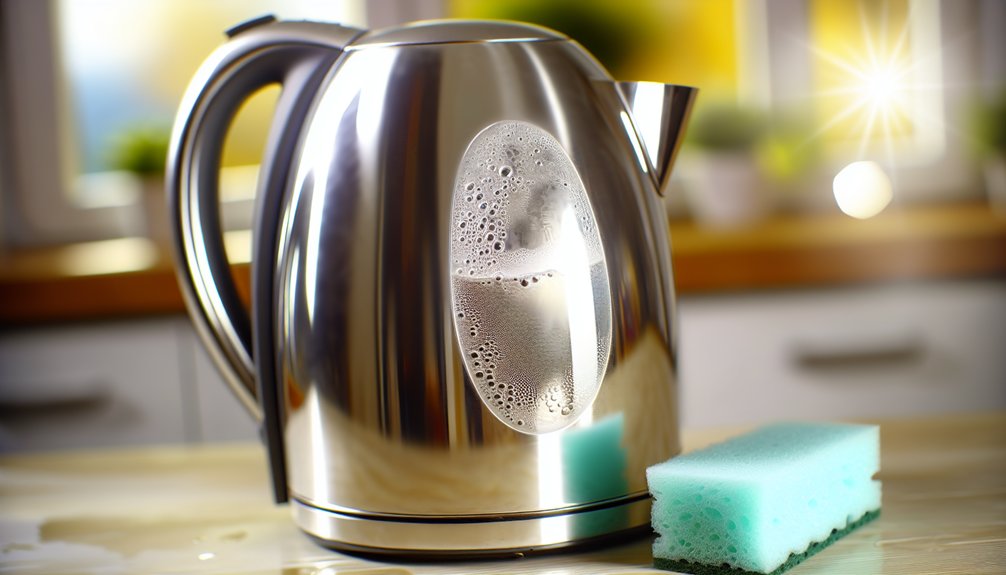
One effective method to deep clean your electric kettle is by using vinegar, a natural descaling agent. Vinegar benefits include its ability to dissolve mineral buildup and eliminate odors, making it a versatile cleaning solution. Here’s how you can use it effectively:
- Mix equal parts of water and vinegar in the kettle.
- Fill the kettle to the maximum level to guarantee thorough cleaning.
- Let the mixture sit for about 30 minutes.
- Boil the solution, then turn off the kettle and cool it down.
- Rinse the kettle several times with fresh water to remove any vinegar smell.
For peak performance, aim to clean your kettle with vinegar every few months, especially if you notice mineral deposits.
Baking Soda Solution for Stubborn Stains
If you’re facing stubborn stains in your electric kettle, a baking soda solution can work wonders. Start by preparing a mixture of baking soda and water, then apply it directly to the stained areas. After letting it sit, rinse thoroughly to reveal a cleaner kettle.
Preparing Baking Soda Mixture
Creating a baking soda mixture is a simple yet effective way to tackle stubborn stains in your electric kettle. To prepare this solution, gather the following ingredients:
- 1 tablespoon of baking soda
- 1 cup of water
- A clean mixing bowl
- A spoon for stirring
- A measuring cup
Start by combining the baking soda and water in the bowl until it forms a paste. This mixture harnesses the cleaning benefits of baking soda, which is great for lifting grime and mineral deposits. It’s non-toxic, making it safe for your kettle. Once your mixture is ready, you’ll be all set to apply it to those persistent stains, restoring your kettle’s shine and ensuring it operates efficiently.
Application on Stains
Once you’ve prepared your baking soda mixture, it’s time to apply it to the stubborn stains in your electric kettle. Start by pouring the baking soda solution directly onto the affected areas. Use a soft sponge or cloth to gently scrub the stains, employing circular motions to maximize the stain removal process. For tougher stains, let the mixture sit for about 15 minutes to break them down effectively. Be careful not to use abrasive materials, as they can scratch the kettle’s interior. Rinse the sponge periodically to avoid spreading grime around. After you’ve tackled the stains, you’ll notice a significant improvement. This effective cleaning technique not only cleans but also helps maintain your kettle’s longevity.
Rinsing and Final Steps
After you’ve scrubbed the stains away, it’s crucial to rinse your electric kettle thoroughly to eliminate any baking soda residue. Start by filling the kettle with fresh water and boiling it. This helps to loosen any remaining particles. Once it’s boiled, pour the water out and repeat the process a couple of times.
Here are some rinsing techniques to guarantee a thorough clean:
- Use distilled water for the final rinse to prevent mineral buildup.
- Check for residue by inspecting the kettle’s interior with a flashlight.
- Pay attention to the spout and lid; they often trap residue.
- Air dry the kettle upside down to avoid moisture buildup.
- Conduct a final inspection before using it again.
Following these steps guarantees your kettle remains in top shape!
How to Use Lemon Juice for a Fresh Clean
Using lemon juice to clean your electric kettle is a natural and effective method that not only removes stains but also leaves your kettle smelling fresh. This process harnesses the acidity of lemon juice to break down mineral buildup, ensuring a thorough clean. Let’s go through the step-by-step cleaning process and some tips to achieve the best results.
Benefits of Lemon Juice
Lemon juice is an excellent natural cleaner that not only freshens your electric kettle but also tackles mineral buildup effectively. By using lemon juice, you’re harnessing the power of its natural acidity and antibacterial properties. Here are some key lemon benefits for your kettle cleaning routine:
- Removes limescale: The citric acid in lemon juice dissolves mineral deposits.
- Freshens up odors: It eliminates any unpleasant smells lingering inside the kettle.
- Eco-friendly: As a natural cleaner, it’s safe for the environment.
- Cost-effective: Lemons are inexpensive and readily available.
- Versatile: You can use lemon juice for cleaning other kitchen appliances too.
Incorporating lemon juice into your cleaning routine guarantees your electric kettle remains fresh and functional.
Step-by-Step Cleaning Process
To achieve a fresh and clean electric kettle, start by gathering your supplies: fresh lemon juice, water, and a soft sponge or cloth. First, mix equal parts of lemon juice and water, filling your kettle halfway. This natural solution effectively tackles mineral buildup without damaging kettle materials. Next, turn the kettle on and let the mixture come to a boil. Once it boils, turn it off and let the solution sit for about 30 minutes. Afterward, carefully pour out the mixture and rinse the kettle thoroughly with fresh water. Finally, wipe the inside with a soft sponge to remove any remaining residue. For ideal performance, aim to clean your kettle every few weeks, depending on your cleaning frequency and water hardness.
Tips for Effective Results
While cleaning your electric kettle, it is vital to maximize the effectiveness of lemon juice for a fresh clean. This natural solution not only removes limescale but also leaves your kettle smelling great. Here are some tips to guarantee effective results:
- Use fresh lemon juice for the best cleaning power.
- Mix lemon juice with equal parts water for an effective solution.
- Allow the mixture to sit for 30 minutes to break down deposits.
- Rinse thoroughly to avoid any citrus residue, especially on stainless steel kettles.
- Clean your kettle every few weeks to maintain peak performance based on your cleaning frequency and kettle materials.
Implementing these tips will keep your kettle in top shape and enhance its longevity.
Regular Maintenance Tips
Maintaining your electric kettle not only guarantees its longevity but also enhances the quality of your brewed beverages. To keep your kettle in top shape, establish a frequency schedule for cleaning—ideally, every few weeks depending on usage. Start by using cleaning tools like a soft sponge or cloth to wipe down the exterior, ensuring you avoid abrasive materials that could scratch the surface. For the interior, a mixture of equal parts water and vinegar works wonders in removing mineral buildup. After letting it sit for about 30 minutes, rinse thoroughly with water. Additionally, always empty the kettle after each use and periodically check for any signs of wear or damage, addressing them promptly to prevent further issues. Regular cleaning helps maintain the kettle’s energy-efficient performance, allowing it to function effectively for various cooking tasks.
Safety Precautions While Cleaning
Before you start cleaning your electric kettle, it’s important to prioritize safety to avoid accidents or damage. Here are some key safety precautions to keep in mind:
- Unplug the kettle before you begin cleaning to eliminate any electrical hazards.
- Use safety gear like gloves to protect your hands from cleaning solutions and hot surfaces.
- Avoid submerging the kettle in water; instead, wipe it down with a damp cloth.
- Check for damage on the cord and base before cleaning; if there are issues, don’t use the kettle.
- Allow the kettle to cool completely before handling to prevent burns.
Frequently Asked Questions
How Often Should I Clean My Electric Kettle?
You should clean your kettle regularly, ideally every month, to maintain its efficiency. Consistent cleaning frequency helps prevent limescale buildup and guarantees peak kettle maintenance, prolonging its lifespan and improving the taste of your water.
Can I Use Bleach to Clean My Kettle?
You shouldn’t use bleach to clean your kettle, as it can leave harmful residues. Instead, opt for vinegar or baking soda as effective bleach alternatives for proper kettle maintenance and safe, thorough cleaning.
Is It Safe to Clean an Electric Kettle With Soap?
You shouldn’t use soap to clean your electric kettle, as it can leave residue. Instead, consider soap alternatives like vinegar or lemon juice. Clean your kettle regularly to maintain its performance and guarantee safe drinking water.
What if My Kettle Has a Plastic Interior?
If your kettle has a plastic interior, prioritize safe cleaning methods. Use a vinegar and water solution instead of harsh chemicals, ensuring you gently scrub without scratching. Regular care keeps it clean and prolongs its lifespan.
Can I Clean My Kettle in the Dishwasher?
You can’t clean your kettle in the dishwasher due to dishwasher safety concerns. Most kettles contain materials like plastic or metal that may warp or degrade, potentially damaging your appliance and affecting its performance.
Conclusion
To sum up, keeping your electric kettle clean is essential for both its longevity and your health. By regularly using methods like vinegar, baking soda, or lemon juice, you can effectively tackle limescale and stubborn stains. Remember to maintain your kettle with routine cleaning to prevent buildup. With these simple steps and precautions, you’ll enjoy fresh-tasting water for your beverages. So, make it a habit to care for your kettle, and it’ll serve you well for years to come!
